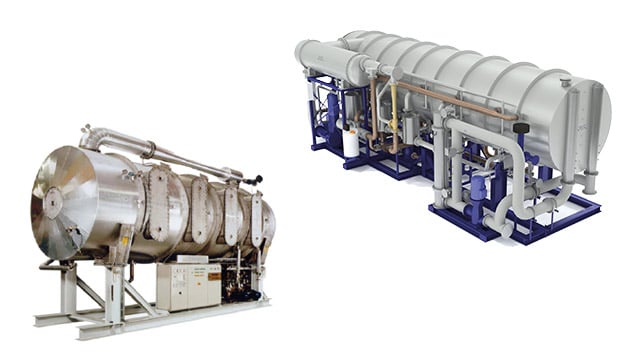MEP - Multi-effect desalination
Fresh water is essential on board any ship, and needs to be available at any time. Whether that’s for human consumption, or for use in operational processes, it needs to be accessible anywhere in the world. With MEP evaporation, you continue to benefit from high purity fresh water even in harsher, variable external conditions.
The more efficient way to generate fresh water
- Low thermal heat and electrical power consumption
- Maintains efficiency and productivity in cold seawater or shallow water
- Can operate on the steam outlet of the steam turbine generator
- Produces high distillate purity of 5-10 ppm
- Water can be used for potable or technical use as required
The plate technology
Alfa Laval's distillation equipment consists of a number of titanium plate heat exchangers, which have been specifically designed for this purpose. All plates are identical; with two gasket configurations being utilised in order to form both a condensing and an evaporating plate channel. Compared to traditional shell and tube technology, the Plate Technology gives higher thermal efficiency. A continuous thin film of water over the entire plate surface also minimizes the risk of deposit build-up (scale) and thereby downtime. Corrosion-resistant titanium heat transfer surfaces and non-coated materials withstand seawater and brines.
Engineered efficiency
Straightforward operation and automated control provide maximum uptime at less cost compared to technologies such as reverse osmosis (RO) and multi-stage flash (MSF). Its lightweight, space-saving design takes up less floor space while offering much higher thermal efficiency in relation to its volume and weight compared to other evaporators. This enables the production of much higher volumes of fresh water than other desalination technologies.
Perfect fit for LNG ships
This technology works exceptionally well LNG fuelled ships, as they will typically have more excess heat available, and MEP works on waste heat recovery. As more ship owners look to make the shift to LNG due to emissions regulations, MEP is the ideal solution to further reduce costs. The fact that this system requires less power, and better facilitates the switch to LNG, also means it can make vessels significantly more environmentally friendly.
How it works
Operating principle
The Alfa Laval MEP desalination process consists of a series of evaporation and condensation chambers known as effects. Each effect is fitted with heat transfer surfaces based on patented Alfa Laval plates. In the plate channels of an effect, the seawater on one side is heated up and partially evaporated to distillate vapour, which is used in the next effect; on the other side, the distillate vapour from the previous effect is condensed, giving up its latent heat, into pure distillate.
By maintaining a partial pressure difference across the effects, the process is able to yield maximum efficiency from available low-grade thermal energy sources. The performance and capital cost of the system are proportional to the number of effects contained in a unit. Seawater is pumped into the system via a seawater pump to a condenser. Here, the seawater acts as a coolant, removing the heat supplied to the system and thereby maintaining the proper energy balance. In the condenser, the vapour produced in the last effect is condensed into pure distillate.
As distillate vapour is condensed, heat is transferred to the seawater. The seawater pump also transports preheated seawater downstream from the condenser to the various effects of the unit for evaporation. The seawater is led towards the evaporation side of the plate stack, creating a uniform and controlled thin film on the plate. To minimize scaling, the special design of the plate surfaces ensures a uniform flow without any dry areas.
On the evaporation side of the plate stack, the seawater is partially evaporated by the heat from the condensation side of the plate stack. The vapour produced is passed through a demister to separate salt from the water droplets before it enters the condensation side of the subsequent heat exchanger plates. Here, the vapour condenses into distilled water while transferring its latent heat through the plates to the evaporation side. The process is repeated in all effects.
Finally, distillate and brine are extracted from the last effect. The evaporation takes place at subatmospheric conditions, and vacuum conditions are created and maintained by a venting system. The venting system is a water-driven ejector, and removes air from the plant at start-up while extracting non-condensable gases during operation of the plant.

